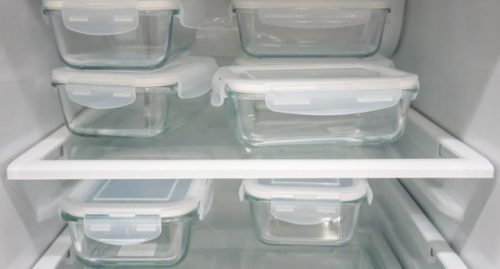Meal prep is more than a food trend: It’s a handy approach you can use to make delicious, homemade food you’ll want to eat every day — without the wait. And while the end results look impressive, meal prep doesn’t require complicated planning or tools. All you really need is time and elbow grease.
This guide to meal prep teaches you everything you need to know about make-ahead meals — plus approaches you can take to ensure your food stays fresh and nutritious.
WHAT IS MEAL PREP?
Simply put, meal prep means prepping for meals. And while single-serve meals are the most common approach to meal prep, there are other types to choose from depending on your schedule, tastes, and dietary needs.
Types of meal prep include:
- Full make-ahead meals: You cook an entire meal and store it in your fridge or freezer.
- Batch cooking or freezing: Make multiple meals, then portion and store them. This approach is useful for recipes you can easily cook in large amounts (like big pots of soup, rice, or mashed sweet potatoes).
- Meals for one: Prepare food and portion it in single-serving containers. (Usually enough to last a few days.)
- Ingredient prep: For people who like to cook and serve food all at once, just prep parts of recipes. Chop veggies, mix spices or marinate meat in advance to save time when you’re ready to cook.
WHY SHOULD YOU MEAL PREP?
Learning how to meal prep will save you time, but it also saves money and reduces waste. And unlike processed meals, this method gives you total control over what goes in your food — perfect for anyone who wants to stay on track with their health goals.
IS MEAL PREP FOR EVERYONE?
Meal prep can benefit people watching their macros or trying to cut down their cook time during the week. However, some forms of meal prep may not be for everyone.
When you cook and store your meals, they may ferment just long enough to cause a negative reaction. How? When packed and stored, leftover food can release histamines as a byproduct of the fermentation process. If you’re particularly sensitive to these compounds, your leftovers could cause brain fog and fatigue.
Since everyone’s histamine tolerance is different, it’s still worth it to try meal prep, avoid high-histamine foods when you cook and see if the process works for you. Consider meal prepping for a shorter time frame, or prepping single ingredients instead of full meals.
WHAT FOODS CAN I MEAL PREP?
You can meal prep any food that holds up well in storage and tastes palatable to you after a few days in the refrigerator. Cooked meat, roasted vegetables, soups, sauces, nuts, and stiff raw vegetables make good bases for meal prep recipes.
But you can’t meal prep everything. Soft vegetables, cut fruit, and crunchy food like crackers will only get softer in your refrigerator — making them less ideal choices for meal prep.
If you’re new to meal prep, think about how you’ll reheat food. Will you only have access to a microwave at mealtime, or can you use a stovetop or oven? Consider recipes that you can enjoy cold or gently reheat so you don’t risk damaging fats and proteins in your food.
Most importantly, choose recipes that you already enjoy leftover and can cook with ease. Then you can branch out with new recipes and food pairings. Keep it simple to start so you don’t find yourself wasting food.
HOW TO MEAL PREP: FIRST STEPS
GET HIGH-QUALITY FOOD STORAGE CONTAINERS
Use quality food storage containers to keep meal prep food hot (or cold). Thermal, stainless steel containers are the ideal solution for keeping food warm or chilled and come in a variety of sizes. You can refrigerate them ahead of time or warm them with boiling water before adding cold or hot foods to make them last even longer. Glassware is the safest solution of all, as long as you plan on enjoying your meal cold and can handle it carefully.
HOW TO MEAL PREP: FOOD SAFETY
Reusable plastics and plastic bags are never recommended for packing meal prep foods. Aside from carcinogenic BPA, even non-BPA plastics can contain estrogenic chemicals[1] that leach into your food and mess with your hormones. And if you heat these plastics in the microwave, you’re also adding radiation to the mix. Avoid storing food in plastic whenever you can to keep your meal prep dishes optimal.
CHOOSE RECIPES AND BUILD YOUR MENU
With simple recipes in hand, decide what you’ll cook for the week and schedule the days of the week when you want to enjoy your meals. Take stock of what you need for those recipes, plus any missing essentials you need (like spices or ghee), and make your grocery list.
SCHEDULE TIME FOR MEAL PREP
You can’t meal prep without prep time. Schedule a window one to two days per week to prep your meals. If you multitask a little (use your oven and stovetop to prep more than one food at once, for example), you’ll cut down on time even more.
There are no hard and fast rules for how long your food will stay fresh. The safety of your meal prep depends a lot on your refrigerator, how you packed it, and the quality of your ingredients.
Start with the FDA’s guidelines for fridge and freezer storage to inform how long you can store meal prep foods, and practice common sense when you pack food so it can last longer. Use divided containers to avoid cross-contamination (or flavor contamination), and pack wet food separate from dry food. Use ice packs to keep cold dishes cold, and pre-warmed insulated containers to keep hot foods hot. And of course, clean your hands and produce before you cook.
Most meal prep meals will last between 3-5 days in the fridge. If you want to meal prep for the whole week, you’ll want to schedule two days a week to do so (such as Sunday and Wednesday) to keep food as fresh as possible.
SHOULD I MEAL PREP IF I DON’T LIKE EATING THE SAME THING EVERY DAY?
Prepping the exact same meal every day can save a lot of time — but it also gets boring. If you tire of eating the same meals over and over, make small tweaks to your meal prep to make each dish a little different. For example, swap in different veggies, sauces, or garnishes for each container to keep things interesting.
Alternatively, you can prep and freeze multiple recipes ahead of time. Then, thaw one or two containers in the refrigerator every day so you can enjoy different dishes throughout the week.
HOW TO MEAL PREP: AVOIDING COMMON MISTAKES
KEEP MEAL PREP SIMPLE
For beginners, start simple. Make one-pot recipes or focus on one main dish, and avoid the temptation to spend a whole day cooking elaborate meals. Too many recipes can complicate your meal prep fast, and you may not want to do it again if it was too hard the first time. Try making just one recipe ahead of time, then meal prep additional dishes when you get comfortable.
PREP BALANCED MEALS
Depending on your diet and health goals, plan meals that will keep you satisfied. It’s easy to make a big bowl of chili for lunch, but it wouldn’t serve as a complete meal for most people. Make sure you get enough of the right food groups to fill out your macros.
COOK RECIPES YOU’LL ACTUALLY EAT
As long as your meal prep dishes are balanced, you don’t need to branch out of your comfort zone. For beginners, make recipes you know you’ll love — anything less could result in wasted food (and wasted time).
MAKE ENOUGH FOOD
Make sure you prep enough food to fit your plan. Furthermore, keep your schedule in mind — events from work lunches to happy hours can interfere with mealtime, so anticipate whether you truly need to meal prep every day.
Call us today to see how we can help you with your meal planning!



